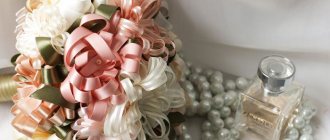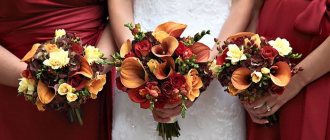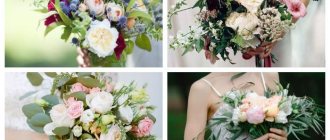The decorative beauty of lilies is appreciated by gardeners and florists. The exquisite “flower of French kings” is majestic without pomp, graceful without pretentiousness, romantic and strict at the same time. The simplest compositions with this popular garden perennial look luxurious. This is why bouquets of lilies, collected by yourself, are so impressive - they do not require complex design, accessible only to professionals.
The flower is most popular in wedding floristry, providing worthy competition to its main rival – the rose. If we turn to floral symbolism, it turns out that lilies are more appropriate in a bride’s bouquet, since they mean innocence and purity, and are also associated with fertility. Although not everything is so simple here.
Rich floral language
Wild lilies, from which over 110 modern species descend, were only snow-white, without any shades. This is confirmed by the ancient Gaulish name “li-li”, meaning “white-white”. It was these flowers that were associated with the divine principle and the highest morality.
Varietal lilies in all their colorful diversity appeared much later. And their symbolism is slightly different:
- orange color means wealth, flirtatious character, some contradictory nature;
- yellow – lightness and cheerfulness;
- coral is associated with the greatness of the soul, grandiose plans and passionate feelings;
- blue symbolizes nobility;
- pink – tenderness and femininity;
- brindle color attracts abundance and prosperity.
The golden lily, endemic to Japan, is considered the embodiment of perfection. Its cost is high compared to other varieties. Therefore, in a bouquet, an elite flower also speaks of a craving for luxury, as well as for everything unusual.
Lilies in a bouquet: pros and cons
The “Royal Flower” was at the peak of fashion a decade ago and has not lost its position since then. It has many advantages over other iconic representatives of the flora: orchids, ranunculus, peonies or eustoma.
- Persistence. Cut specimens remain fresh for 3 to 5 days, which allows you to fully enjoy their beauty.
- Varietal diversity. There are more than 500 shades of lilies, which gives endless scope for the imagination of designers and florists.
- Good compatibility. Harmonizes with many ornamental plants, exceptions are rare.
- Long flowering. Some species can be found in the garden from May to September. And in flower shops, the availability of elegant beauties does not depend on the season and their prices hardly change.
- Versatility. A beautiful bouquet of lilies can be of any style and shape.
- Healing properties. The aroma of some varieties is considered medicinal; it effectively eliminates depression and lifts the mood.
There are also some negative aspects. The fragrant plant, on the one hand, heals, but on the other hand, it can cause headaches and spasms in people sensitive to strong odors. For bouquets, it is recommended to choose varieties with a delicate aroma, without pronounced spicy notes.
Another unpleasant “touch” can be lily pollen. For humans, contact with it will only result in bright, difficult-to-remove stains on clothing, but pets can become very ill and even die. Cats are especially vulnerable in this regard; “washing” their fur coat of pollen that has fallen on it ends in acute renal failure.
Floral arrangements with the “royal flower” should be kept as far as possible from four-legged pets in order to avoid sad consequences. It is even better to remove the anthers of the stamens from freshly cut plants.
Legends of origin
There are many legends about the origin of calla lilies. Here are some of them:
Generally accepted
One of them says that a long time ago, when the Gods descended to earth, the daughter of a powerful Deity fell in love with an ordinary earthly guy. He reciprocated, and the young people began dating. The girl's father, having learned about this, became angry and forbade his daughter to go down to earth.
But can anything stop the lovers? Having learned about his daughter’s disobedience, God turned her invisible. But this did not stop the girl. Every day she went down to the young man. The guy, in order to somehow feel and see his beloved, wove a blanket of beautiful flowers and threw it over her.
The lovers cried for a long time about their fate; after seeing this, the father had mercy and lifted the curse.
The blanket fell off the girl, and after some time charming flowers grew in this place. Since then, calla lily has been a symbol of purity and purity.
Greek
Another legend dates back to Greek mythology. The myth tells that Zeus brought his newborn son Hercules to the sleeping goddess Hera to give him milk.
Waking up, the goddess unexpectedly pushed the baby away and spilled milk, which formed the milky way. A few drops fell to the ground and turned into beautiful, majestic flowers of snow-white purity.
Seeing such perfect plants, the goddess of beauty and passion Venus was jealous of their charms and imposed a curse. As a result, a large thorn (pistle) appeared in the heart of the flower. Thus, the goddess wanted to disfigure and deprive him of his purity.
A large pestle also appeared according to legend
According to one of the most famous legends, a barbarian leader fell in love with a girl from a poor tribe with snow-white skin and big eyes. Having found reciprocity, he became angry and, in anger, threatened his chosen one to destroy her tribe if she did not marry him.
The girl, having a kind heart, accepted the offer in order to save her family.
On the wedding day, on the way to the groom, the bride saw a large fire that was lit for the ceremony. Without hesitation, she decided to throw herself into it, but as soon as the beauty took the first step towards the fire, she immediately turned into a snow-white flower.
Since then, they have been protecting girls from the evil eye and evil of ill-wishers, giving them confidence and guiding them on the right path. They help you find happiness in love and protect you from quarrels.
The most decorative varieties
Not all types of luxurious perennials are equally good in flower arrangements. Among all the diversity, experts recommend choosing Asian and Oriental hybrids. The former are distinguished by their bright, exotic color and are almost odorless. The second ones are larger, with a refined shape and a rich, sweetish aroma. Also of interest are long-flowered hybrids with elongated cups resembling a gramophone.
Marlene is an Asian variety with a soft pink color. Ideal in wedding bouquets or interior compositions. The aroma is subtle and fresh. The petals look like Japanese porcelain.
Annamarie's Dream - snow-white, less often cream, double flowers with dark burgundy stamens. Perfect for compositions with different types of plants.
Black Out is a dark red variety with dense glossy petals. Very beautiful in bouquets for special occasions, such as anniversaries or birthdays.
Lollуpop is a favorite of florists. Large white buds with raspberry tips are impressive and especially popular with brides.
Lovely Girl is the most beautiful oriental hybrid. Cream flowers with a yellow center and golden specks do not require additional decoration. They are used to make mono-bouquets, including wedding ones.
Marlene
Annamarie's Dream
Black Out
Lollpop Lovely Girl
Bouquet of lilies
What plants are suitable?
Types of flowers suitable for the bride's bouquet:
- roses - require pruning of thorns;
- peonies - June wedding;
- chrysanthemums - combined with small bright flowers, good in winter;
- hydrangeas - ideal for a spherical bouquet, as well as a winter option, they have bright colors (blue, pink, purple);
- ranunculi (orange, pink, white) - combined with roses, peonies, lilies;
- eustoma - for tulips, roses;
- orchids - for cascading mono-bouquets and in an ensemble with greenery;
- calla lilies - as an addition to bright small flowers;
- lilies - choose a variety without a strong odor;
- carnations - to dilute the snow-white bouquet;
- gerberas - will give unusually bright autumn colors;
- freesia is an aristocratic flower;
- anemones – arrangement option with freesia;
- dahlia - for a bright autumn wedding in country style;
- tulip - bloom quickly;
- wildflowers as an addition - daisies, mallow, jasmine, cornflower, forget-me-not;
- greens: salal, ruscus, eucalyptus, aspidistra leaves, ivy, fern.
White peonies and soft pink roses go well together. A bouquet of blue and purple airy hydrangeas is extremely beautiful. At a spring wedding, tulips in mono-bouquets and lilies of the valley look great; in the fall, a lush range of colors and a riot of bright colors of dahlias and chrysanthemums look great. Roses are good all year round. And for a summer wedding, preference is given to a bouquet of callas, orchids and lilies.
Royal luxury wedding bouquet
Flowers are the best decoration for any bride. It is not surprising that every girl chooses bouquet arrangements for the happiest day of her life with special care. But if she prefers lilies, there will be much less hassle with the main wedding accessory. What should you pay attention to first?
- Flowers and the dress should be in harmony with each other, sharp contrasts should be avoided. A bright, lavishly decorated outfit involves the use of a mono-bouquet: pure white or light pastel shades.
Tip: to make the floral accessory look festive, you can sprinkle it with glitter varnish and decorate it with rhinestones.
- The shape of the “living decoration” depends on the height and figure of the bride. For tall girls, cascading or “drop” type compositions are suitable, as well as the sharply fashionable “ball”, which is worn on a chain like a handbag. Newlyweds of average height should pay attention to the hemisphere and Biedermeier, and petite beauties should pay attention to glamelia.
- A variety of greenery should be added to a mono-bridal bouquet of lilies, but artificial accessories - ribbons, bows, jewelry - should be avoided.
Combination with other plants
The most common and popular is a wedding bouquet of lilies and pink buds - plain or in pastel colors. In second place is the combination with small chrysanthemums, creating an interesting play of textures and volumes. On the third – an exotic combination with orchids, balancing on the verge of aristocratic whim and ridiculous bad taste.
A “duet” with gerberas can be called neutral, fresh and romantic with freesias, daisies and hydrangeas. You can add a “cloud” of aerial gypsophila to any composition. Since lily petals have a pointed shape, their “partners” in the bouquet should be round, with soft but lush outlines.
For greenery, you should pay attention to the leaves of irises or peonies, asparagus and fern.
Florists strongly advise avoiding “tandem” with carnations, daisies, poppies and cornflowers.
Armed with some knowledge, you can try to make a wedding bouquet of lilies with your own hands, especially for those craftswomen who are going to get married soon. However, it is not at all necessary to create such beauty only for yourself; it is worth sharing with friends or even having it made to order.
Classification by style
Modern floristry distinguishes several basic styles, thanks to which it is possible to create the ideal bouquet for any life event.
Vegetative style
The vegetative composition is a complex, skillfully assembled bouquet that looks as natural as possible and close to natural conditions. Very often it is called a piece of nature, since its creation not only uses natural materials, but also takes into account the basic characteristics of the plant world.
When creating a vegetative bouquet, pay attention to the following factors:
- Asymmetrical and symmetrical arrangement of plants;
- Grouping, proportions and examples of growth in the natural environment;
- Natural color and shape of plants;
- Seasons - seasonality allows you to understand what materials should be combined.
This composition is minimally decorated, but despite this, it looks incredibly stylish and elegant.
Decorative style
Decorative style allows you to create bouquets in a single concept, sometimes from completely dissimilar materials. In this case, the plants lose their individuality, but this is more than compensated by the overall expressiveness of the bouquet.
The features of this style are the following:
- Plants should fill the bouquet tightly to the center;
- Both asymmetry and symmetry are allowed;
- Various natural and artificial materials are used and grouped together in the work;
- Color contrasts are used because color is very important in composition;
- It is allowed to combine stylistic features of different eras;
- Overall visual balance is maintained.
This style is quite bright and convenient to perform, so many florists prefer to use it in their work.
Shape - linear style
Contours, line and shape are the main elements of the form-linear style. They set the tone for the entire floral composition. In this case, an important condition for the work is such a combination of elements in which the bouquet will acquire expressiveness.
This style has the following characteristics:
- The use of many shapes and lines is not allowed;
- The form must remain clear;
- To create a bouquet you need a minimalist amount of material;
- The arrangement of the material should be asymmetrical, although symmetry is sometimes allowed;
- A combination of plant and artificial materials;
- Contrasts and juxtapositions are used;
- The bouquet should maintain space.
Bouquets in this style are very suitable for interior arrangements and various conceptual events.
Massive style
One of the clear and understandable compositional styles is the massive style, which is also called style-form. The execution of these compositions is quite simple, but at the same time labor-intensive. The shapes of the bouquets are clear, for example, a cone, a heart or a ball, the main thing is to decide on the execution technique.
To assemble massive bouquets, you can use various techniques, such as arrangement on a base, gluing, weaving, parallel or spiral assembly, and others.
In addition, when using a form style, the following is recommended:
- It is advisable to use no more than 3 types of material;
- The composition does not need a center, so the bouquet must be filled tightly;
- When assembling, you must adhere to a strictly chosen form;
- If the bouquet involves a base, for example, a vase, then it should be compositionally combined with the bouquet.
It is worth additionally noting that the development of styles does not stand still and modern floristic schools have recently sought to highlight new directions, one of which in the near future may become a transparent style.
Round composition in a porta bouquet
Before you start assembling, lilies should be immersed in a container of cold water for 2 hours. This way they will stay fresh longer.
We will need:
- porta bouquet holder;
- oasis (floral sponge);
- satin ribbon;
- double-sided tape, glue gun, sharp knife, wire.
And, of course, “live” material.
- First, let’s lower the oasis into water so that it is well hydrated, because it is this simple device that creates a comfortable environment for fresh plants. When the sponge darkens and sinks to the bottom, it is removed and placed in a porta-bouquet holder, secured with wire. The leg of the plastic stand is stuffed with paper towels to prevent water from leaking out.
- Next, you should disguise the “base” with large decorative leaves, making the so-called “arrangement skirt”. We attach the natural props to special floral glue.
- We cut the lily stems to 6 cm, otherwise the material will fall out of the porta bouquet under its own weight. We arrange the flowers radially, starting from the bottom tier. We monitor the shape of the bouquet - it should be round so that individual elements do not stand out from the overall composition. We use both fully blossomed and closed buds, alternating them with each other.
The stems at the point of contact with the sponge can be filled with glue for reliability.
- We fill the space between the main elements with gypsophila and greenery, or small half-blooming roses (chrysanthemums). For reliability, we braid the composition on top with the thinnest wire-broth.
- We wrap the handle of the bouquet holder with double-sided tape and decorate it with a satin ribbon to match the wedding dress, lace, and rhinestones. Another option is to use natural flower stems or a bergrass substitute for decoration. This technique allows you to achieve maximum naturalness and is very popular among florists.
Triple origami lily with green backing
The original lush lily using the origami technique can easily be supplemented with a green base for a more natural look.
The base is formed using a simple lily manufacturing pattern. However, other steps will be required in the final stages.
- The workpiece is carefully stretched to the sides.
- The internal parts are smoothed and folded inward.
The finished parts of the flower are inserted inside the substrate and secured. You can decorate a child’s room with this craft or use it for a school exhibition.
Lilymelia
A variety of glamelias - fantastic peony camellia buds, collected from many flower petals. In this case, lilies. Glamelias are by no means a floral novelty, as is commonly believed; they appeared back in the 19th century. But today they are again at the peak of wedding fashion, eclipsing the traditional “Biedermeier” and “scepter” designs.
You can make a unique masterpiece from petals with your own hands. For this you will need:
- lily buds, longiflorum varieties, 8 – 15 pcs.;
- greenery;
- decorative beads and pendants;
- satin ribbon, 1 cm wide to match the petals, similar twisted cord;
- heat gun, floral glue;
- narrow stationery tape, tape;
- knife;
- wooden stick, 30 cm long.
Carefully separate each bud, not completely separating the petals, so that you get a kind of “ribbon”. Use tape to remove any loose pollen. We collect the stamens separately into bundles and attach them to wire.
We free the half-opened bud from the stem. We strengthen it with a wire pin and wrap it with tape to a wooden base stick. We place the stamens around the bud and “take it all together with tape.”
The next layer will be “ribbons” of opened flowers. We wrap the workpiece with them and secure it with tape. We place layers of stamens and petals one by one, each time moving them down a little so that the composition resembles a “gramophone” in shape. At the end of the work, wrap the fastening area with tape several times.
We decorate the free end of the stick with a large glass bead, placing it on a wire pin and wrap the holder with a satin ribbon. We “plant” the lily leaves in a circle on floral glue, covering the junction of the lilymelia with the wooden base. Taping greens. We decorate the handle with a twisted cord, and the ends of the stamens with light transparent beads. You can replace the leaves with beautiful feathers to match the color of the petals.
The “lifespan” of a floral masterpiece is no more than 12 hours, but this is enough for the bride to have time to amaze those present and have a beautiful photo shoot.
An approximate scheme for creating lilymelia:
And here’s how luxurious the finished composition looks.
The final stage: packaging
For quite a long time, no special importance was attached to the design of packaging for bouquets of fresh flowers; its role was played by transparent cellophane. Later, packaging made of bright corrugated paper, fancifully decorated with prints and scallops, and complemented with floral mesh, became a sign of good taste.
Peonies in craft paperSource flowerbulbs.nl
To date, there has been a trend towards the use of more discreet and sophisticated packaging for flowers; Florists know how to properly arrange a bouquet. They offer a lot of interesting materials. The following options are common:
Paper. Paper packaging is still in trend due to its practicality and variety. It can be monochromatic, with thematic patterns and reliefs; Kraft paper is gaining popularity. Texture types are interesting: corrugated, waffle, crinkled, crepe. Korean packaging (tracing paper) is becoming popular, which does not wrinkle and gracefully deforms around the bouquet.
Corrugated paperSource prom.st
Fabrics. Elegant and soft artificial linen goes well with any floral arrangements. Rough jute burlap made from natural raw materials is suitable for exotic flowers. Floral felt, light and moderately dense, is suitable for both voluminous, tall bouquets and small buds.
Bouquet in burlapSource wallbox.ru
With an ear of cornSource flowerray.rf
Synthetic film is still popular. It is varied in texture and not only decorates the bouquet, but also maintains a humid microclimate, and also protects the flowers during transportation.
Black kraft paperSource pestro.by
Sometimes you have to create packaging from what you have on hand
Stylish options include packaging that does not distract attention from the bouquet and has a slightly careless appearance. If you don’t know how to beautifully pack a bouquet of flowers, opt for craft or Korean paper
You can pack one rose beautifully using tissue paper (tishyu). If you are familiar with the recipient's tastes, perhaps an unusual option: an old sheet of music or a magazine sheet will do.
In pink paperSource photostockeditor.com
About fashionable packaging methods in the following video:
A gift from your own garden
A bouquet of garden lilies can be given for a birthday and September 1, an important family date, or just to please a loved one. It's not difficult to do, but you need to remember some rules.
Plants are cut early in the morning or in the evening in a state of half-open buds. The lower leaves must be removed so that they do not rot in the vase later. It’s also better to get rid of the anthers. The stems are cut obliquely in a sector, slightly varying the length - for naturalness.
The bouquet composition is assembled using the so-called “spiral technology”, placing the stems on top of each other obliquely and at an angle, and then twisting them a little more around the axis. We leave the top leaves, it is advisable to add sprigs of lush garden greenery to them. You can “dilute” lilies with eustoma of the same shade. The composition looks most luxurious in milky white color.
We hold the plants in our hands and periodically secure them with tape so that they do not fall apart. Be sure to add long sprigs of asparagus or fern to avoid monotony. At the end, we wrap all the stems several times with tape and wrap our work in craft paper. Its rough texture will emphasize the delicate fragility of garden flora.
Activated carbon or aspirin must be added to the water where the bouquet will stand for disinfection.
How to assemble a bouquet of lilies: video master class
How to preserve the beauty of flowers
Regular replacement of water or nutrient solution helps to maximize the preservation of cut flowers. Sugar also prolongs their life - 30 g per 1 liter of water. Silver nitrate (30 mg per 1 liter of water) or aspirin, pine extract are suitable for disinfection. Flowers with signs of wilting should be removed, leaving the remaining buds the opportunity to gain strength for full flowering.
In this article we will tell you why white roses are given as gifts. The color of roses - what each one means.











